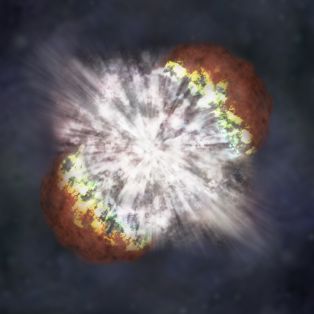The Mysterious Mass Gap Sheds Light on Supernova Explosions
2013-02-27
For over 10 years astronomers have been trying to understand the dearth of neutron stars and black holes in mass range 2-5 solar masses. This striking"mass gap", as lighter neutron stars and heavier black holes do exist, poseda challenge for theorists and observers alike.
Scientists from Astronomical Observatory, Faculty of Physics at Warsaw University in collaboration with American researchers have solved the puzzle and provided new insights into inner workings of supernova explosions.
For over 10 years astronomers have been trying to understand the dearth of neutron stars and black holes in mass range 2-5 solar masses. This striking "mass gap", as lighter neutron stars and heavier black holes do exist, posed a challenge for theorists and observers alike.
Both neutron stars and black holes are born in supernova explosions that mark the end of a star's life. Lighter stars form smaller neutron stars, while more massive stars form heavier black holes. Since stars are found over a broad range of mass, with no apparent gaps, it was expected that compact objects should be correspondingly found over entire allowed mass range. However, this intuitive prediction is not borne out by the decade of new observational data.
Scientists from Astronomical Observatory, Faculty of Physics at Warsaw University in collaboration with American researchers (Los Alamos National Laboratory, University of Chicago, Northwestern University) have solved the puzzle and provided new insights into inner workings of supernova explosions. The supernova engine, hotly debated over last decade, is far from being understood. Due to short timescales and heavy veiling by surrounding stellar material the inner supernova engine is almost impossible to probe directly via electromagnetic observations. The team led by K. Belczynski delivered a first physical explanation of the mass gap and was able to provide strong constraints on the supernova explosion development time. It appears that only explosions driven on extremely short timescales (100-200 milliseconds) can accommodate the mass gap. So far much longer timescales were considered as well and this result is likely to help pinpoint the exact physical processes (or instabilities) driving the explosions.
As a massive star collapses at the end of its nuclear evolution, the inner part of stellar core forms a very hot proto neutron star. The layers above fall toward this hot object, bounce back and expand outward. At first, it was believed that this expanding gas may lead to ejection of outer stellar layers and supernova explosion. However, the expanding gas encounters the outer stellar atmosphere and the outgoing shock stalls. The new calculations show that convection may revive the outgoing shock and lead to supernova explosion. Layers just above the proto neutron star are heated by neutrinos and the gas is subject to large convective motions. The amplitude and strength of convective motions grow in time and at some point it may become strong enough to overcome the pressure of the outer stellar layers ejecting them into the space in spectacular supernova explosion. If convective engine turns on just after the formation of proto neutron star, the low mass stars explode almost immediately leaving behind 1-2 solar mass neutron stars. For high mass stars, the layers above proto neutron star are so dense that the early convective engine is not able to launch the explosion and entire star collapses forming a black hole with mass larger than 5 solar masses. This leads naturally to the formation of mass gap.
The original scientific article was published in The Astrophysical Journal.






